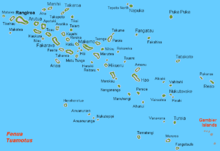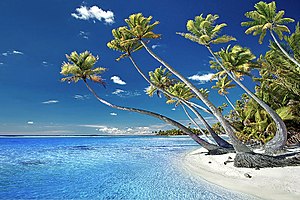Rangiroa
 NASApicture of Rangiroa Atoll | |
| Geography | |
|---|---|
| Location | Pacific Ocean |
| Coordinates | 15°07′31″S147°38′43″W/ 15.12528°S 147.64528°W |
| Archipelago | Tuamotus |
| Total islands | 415 |
| Area | 1,446 km2(558 sq mi) (lagoon) 79 km2(31 sq mi) (above water) |
| Length | 80 km (50 mi) |
| Width | 32 km (19.9 mi) |
| Highest elevation | 12 m (39 ft) |
| Highest point | (unnamed) |
| Administration | |
| Overseas collectivity | |
| Administrative subdivision | Tuamotus |
| Commune | Rangiroa |
| Capital city | Avatoru |
| Largest settlement | Tiputa(pop. 817) |
| Demographics | |
| Population | 2567[1](2012) |
Rangiroa(Tuamotuanfor 'vast sky') orTe Kokōta(Cook Islands Māorifor 'theHyades star cluster') is the largest atoll in theTuamotusand one of the largest in the world (smaller thanKwajaleinin theMarshall IslandsandHuvadhuin theMaldives).
It is inFrench Polynesiaand is part of thePallisergroup. The nearest atoll isTikehau,12 kilometres (7.5 mi) to the west. It is about 355 km (221 mi) northeast ofTahiti.Rangiroa is home to about 2,500 people on almost 80 km2(31 sq mi). The chief town isAvatoru,in the atoll's northwest.
Geography and environment[edit]

Theatollconsists of about 415motus,islets and sandbars comprising a total land area of about 170 km2(66 sq mi). There are approximately one hundred narrow passages (straitsor passes), calledhoa,in thefringing reef.The atoll has a flattenedelliptic shape,with 80 km (50 mi) in length and a width ranging from 5–32 km (3.1–19.9 mi). The width of land reaches 300–500 m (980–1,640 ft) wide and itscircumferencetotals up to 200 km (120 mi). Thelagoonhas a maximum depth of 35 m (115 ft) and its surface is 1,446 km2(558 sq mi).[a]It is so large that it has its own horizon.[2]Due to its shallow depth, the currents that come in and out through the passes, together with the winds, can sometimes create interior storms.
Because of their large size, and the existence of only two passes, eachhigh tidecreates a strong incoming current, while each low tide creates a strong outgoing current within the two passes. While flowing inward throughTiputa Pass,nearly 200 individual sharks will gather at the entrance to the pass, at a depth of 50 meters (160 ft). Led by the strong current, sharks can remain motionless. Divers are able to observe them without difficulty. Largemanta ray,green sea turtle,andhumphead wrasseare also seen. During summer (December-March),tigerandhammerhead sharkare present. In January, large numbers ofstingraygather in the Tiputa Pass, as do the hammerheads that feed on them.
Water and ecological problems[edit]
Like many atolls,[3]Rangiroa has no permanent freshwaterbodies,and therefore no centralwater distribution system.Each household must collect and store rainwater incisterns.As a result of excessive pumping, thefreshwater lensesthat form on thecoral reefsare now mostlybrackish water,[4]leading tosaltwater intrusion.[5]
Some are additionally polluted bylandfill.As atolls form on the surface of the ocean,freshwatersupplies are contaminated by the burial of waste, often accumulated in unregulated dumps or buried only a few meters deep.[6]Such problems of water supply andwaste managementare common on atolls with the adoption of contemporary living conditions, and are therefore structural, as in the case of Rangiroa.[7][8][9]
In addition to this inherent problem, the progress ofglobal warmingand the consequentrise in sea levelsthreaten the island. In common with other atolls, Rangiroa'secologyand its viability as a permanent habitation forhumansare based on a highly vulnerable ecosystem that is delicately balanced, so requiring careful resource management.[10][11]
History[edit]
It is believed the first settlers arrived on Rangiroa around the 10th century AD.[2]The first recorded Europeans to arrive on Rangiroa were Dutch explorersJacob le MaireandWillem Schoutenduring their 1615-1616 Pacific journey. They called this atoll,Vlieghen Eiland,or 'Island of Flies', because their landing party returned to the ship covered in black flies. Rangiroa appears in some maps asNairsaor asDean’s island.John Byron,passing the atoll during his circumnavigation in 1765, named it for thePrince of Wales.This atoll was visited by theCharles Wilkesexpedition on 7 September 1839.
During the 1950s, the economy of Rangiroa was driven by fishing and the production ofcopra.The inauguration of theRangiroa Airportin 1965 allowed rapid development of the tourism industry as underwater diving facilities and hotels were built.

Administration[edit]
The atoll of Rangiroa is thechef-lieuof thecommuneofRangiroa,which consists of two other atolls (TikehauandMataiva) and a separate non-atoll island (Makatea).
Demography[edit]
Only two islands, at the northern end of the atoll, are permanently inhabited. As of 2007[update],the total population on the atoll of Rangiroa was 2,473 inhabitants. The main villages areAvatoru(pop. 817),Tiputa(pop. 971), Ohutu (pop. 546), Taeo'o, Fenuaroa, Otepipi and Tevaro. Both Avatoru and Tiputa were built on neighboring islands, 12.5 and 4 km (7.8–2.5 mi) in length respectively. They are separated by the majorTiputa Pass.The other major pass of the atoll isAvatoru Pass,immediately to the west of the island of Avatoru.
Religion[edit]
As in the rest of the Tuamotu Islands, the majority of the inhabitants areChristians,as a consequence of missionary activity by both Catholic andProtestantgroups. TheCatholic Churchadministers 3 religious buildings on the atoll: the Church of St. Michael in Avatoru (Église de Saint-Michel),[12]the Chapel of St. Anne in Otepipi (Chapelle de Sainte-Anne),[13]and the Church ofOur Lady of Peacein Tiputa (Église de Notre-Dame-de-Paix),[14]all under the Archdiocese of Papeete based on the Island ofTahiti.
Economy[edit]
Pearls[edit]

The breeding of pearl oysters in the lagoon can produceblack pearls.Black pearls (meaning the marine cultured pearls produced from the black lippearl oystershell,Pinctada margaritifera) are abundant in the atolls of French Polynesia. These pearls, which have a wide range of natural colours, from white to dark and all shades of grey, are the only cultured pearls in the world with so many different natural colours as the famous green rose peacock.
The technique to produce marine cultured pearls was developed in Japan and, except some minor details, is similar in French Polynesia. A mother of pearl bead is inserted in the animal together with a piece of tissue (mantle) taken from another pearl oyster. The piece of tissue, as a graft tissue, will develop quickly and will form a skin around the bead and then will deposit mother of pearl on the surface of the bead. Bead rejection is important and concern about 30 percent of the seeded shells, mainly because the graft tissue is not close enough to the bead. Even with perfectly round beads, only 20 percent of the pearls will be perfectly round at the harvest, about two years after the seeding.
Pearl farming is done in more than 30 atolls of French Polynesia and is the main activity for numerous families in theTuamotu archipelago.In Rangiroa, a few farms exploited about 1,000 acres (4.0 km2) of water surface in the lagoon loaned by the Tahitian government. The biggest farm, Gauguin's Pearl[15]employed more than 50 local workers, with a strong impact on the economy of this 2,000 person atoll. A school dedicated to the pearl farming techniques and a research centre on pearl oysters are also implanted on the atoll of Rangiroa, which make it a kind of pearl centre for this industry.
Fishing[edit]

Essentially a part of food production, however, it is also exported to the island of Tahiti.
Viticulture[edit]
The atoll of Rangiroa is also known for its vineyards, which are unique in the world.[16]The vines grow on the edge of a lagoon beside coconuts, and produce two harvests per year. The winery is in the heart of the village of Avatoru. The grapes are brought to the winery by boat.
The creation of this vineyard came after much prior analysis, to find the best site capable of hosting the vines. The first vines were imported in 1992 and underwent tests for acclimatization and selection in the main islands of Polynesia, with the uncertainty of their adaptation to climate. Thirty varieties were imported from various parts of Europe. The vineyard is Domaine Dominique Auroy.[17]
The tests took place in:
- TheAustral Islandson the highRurutuandTubuai,
- Nuku Hiva(Marquesasarchipelago),
- Rangiroa (Tuamotu archipelago),
- The plains and mountains ofTahiti.
The atoll of Rangiroa was selected for the following reasons: absence of grapevine pest such as defoliating insects (e.g.,Grape Phylloxera) and its proximity to Tahiti. Thevarietalsgrown on the atoll includeCarignan,ItaliaandBlack Muscat.
Tourism[edit]

Tourism is a major economic activity of the island: daily connections with Tahiti, an exceptional lagoon and passes which are good sites for scuba diving attract a steady number of tourists. These are accommodated in hotels and family-run guesthouses, a small number of which exist on the island.
Scuba diving[edit]
Rangiroa is a majorunderwater divingdestination because of the lagoon's clear waters and diverse marinefauna.[2]There are several highly-regarded and popular diving sites, particularly in and around theTiputa Pass,which runs 3.5 km (2.2 mi) to the Avatoru Pass. Sedentarycommon bottlenose dolphins(Tursiops truncatus) are regularly seen at group play in the pass. Many forms of marine life are present in the atoll's waters, providing opportunities for observation to divers andsnorkellers.

Popular diving sites are the Blue Lagoon, Avatoru Pass, Tiputa Pass, andLes Sables Roses('the pink sands'). A notable site in the atoll is theBlue Lagoon,which is a smaller lagoon formed on the southwestern edge of Rangiroa. Its shallow waters accentuate the bright blue color of the water.Les Sables Rosesare sandbars of pink sand located on the southeastern portion of Rangiroa.
Transportation[edit]
Air transportation is available from and toRangiroa Airport,located on the Avatoru Island. There are flights to Tahiti and other atolls of the French Polynesia. A small road made oftarmacand coral chips circles the island of Avatoru.
Notes[edit]
- ^All figures approximate
See also[edit]
References[edit]
- ^"Population".Institut de la statistique de la Polynésie française.Retrieved15 October2014.
- ^abcRangiroaArchived2012-05-26 atarchive.todayPublisher: Centre d'Océanologie de Marseille. Accessed 14 February 2010
- ^E. Tang, E. Raapoto, T. Stampfler, « À peine plus de la moitié des Polynésiens ont de l'eau potable », Polynésie 1ère, 17 mars 2016
- ^Mireille Loubet, « En Polynésie, l'eau potable ne coule pas de source », Tahiti-Infos, les informations de Tahiti, 20 août 2014
- ^The Ghyben-Herzberg ModelAccessed February 16, 2010
- ^« Eau potable et traitement des déchets pour Jean Jacques Urvoas à Rangiroa », Polynésie 1re, 3 mars 2015
- ^Nunn, Patrick; Kumar, Roselyn (6 March 2018)."Understanding climate-human interactions in Small Island Developing States (SIDS): Implications for future livelihood sustainability".International Journal of Climate Change Strategies and Management.10(2): 245–271.doi:10.1108/IJCCSM-01-2017-0012.
- ^Holding, S.; Allen, D. M.; Foster, S.; Hsieh, A.; Larocque, I.; Klassen, J.; Van Pelt, S. C. (December 2016)."Groundwater vulnerability on small islands".Nature Climate Change.6(12): 1100–1103.Bibcode:2016NatCC...6.1100H.doi:10.1038/nclimate3128.ISSN1758-6798.Retrieved31 October2021.
- ^Rotzoll, Kolja; Fletcher, Charles H. (May 2013)."Assessment of groundwater inundation as a consequence of sea-level rise".Nature Climate Change.3(5): 477–481.Bibcode:2013NatCC...3..477R.doi:10.1038/nclimate1725.ISSN1758-6798.
- ^Nurse, L.A.; McLean, R.F.; Agard, J.; Briguglio, L.P.; Duvat-Magnan, V.; Pelesikoti, N.; Tompkins, E.; Web, A. (2014)."Small islands"(PDF).In Barros, V. R.; Field, C.B.; Dokken, D.J.; Mastrandrea, M.D.; Mach, K.J.; Bilir, T.E.; Chatterjee, M.; Ebi, K.L.; Estrada, Y.O.; Genova, R.C.; Girma, B.; Kissel, E.S.; Levy, A.N.; MacCracken, S.; Mastrandrea, P.R.; White, L.L. (eds.).Climate change 2014: Impacts, adaptation, and vulnerability. Part B, Regional aspects. Contribution of Working Group II to the Fifth Assessment Report of the Intergovernmental Panel on Climate Change.Cambridge: Cambridge University Press. pp. 1613–1654.ISBN9781107415386.Retrieved31 October2021.
- ^Newman, Joanna (2 January 2019)."Islands' institutes band together against climate change".Nature.565(7737): 25.Bibcode:2019Natur.565...25N.doi:10.1038/d41586-018-07873-1.PMID30602746.S2CID57373567.Correspondence.
- ^"Église de Saint-Michel".GCatholic.Retrieved2021-09-22.
- ^"Chapelle de Sainte-Anne".GCatholic.Retrieved2021-09-22.
- ^"Église de Notre-Dame-de-Paix".GCatholic.Retrieved2021-09-22.
- ^Gauguin's Pearl
- ^"Tahitian Wine".Wine-Searcher.Retrieved2017-07-17.
- ^"Bienvenue au Domaine".Vin de Tahiti.Retrieved17 July2017.

